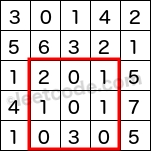308 Range Sum Query 2D - Mutable
1. Question
Given a 2D matrixmatrix, find the sum of the elements inside the rectangle defined by its upper left corner (row1,col1) and lower right corner (row2,col2).
 The above rectangle (with the red border) is defined by (row1, col1) =(2, 1)and (row2, col2) =(4, 3), which contains sum =8.
The above rectangle (with the red border) is defined by (row1, col1) =(2, 1)and (row2, col2) =(4, 3), which contains sum =8.
Example:
Given matrix = [
[3, 0, 1, 4, 2],
[5, 6, 3, 2, 1],
[1, 2, 0, 1, 5],
[4, 1, 0, 1, 7],
[1, 0, 3, 0, 5]
]
sumRegion(2, 1, 4, 3) -> 8
update(3, 2, 2)
sumRegion(2, 1, 4, 3) -> 10Note:
The matrix is only modifiable by the update function.
You may assume the number of calls to update and sumRegion function is distributed evenly.
You may assume that row 1 ≤ row2 and col1 ≤ col2.
2. Implementation
(2)2D Binary Indexed Tree
思路: 二维的树状数组其实相当于每一行都是一个binary indexed tree
3. Time & Space Complexity
Binary Indexed Tree: 时间复杂度: Binary Indexed Tree创造: O(m * logm * n * logn), update: logm * logn, query: logm * logn
Last updated
Was this helpful?